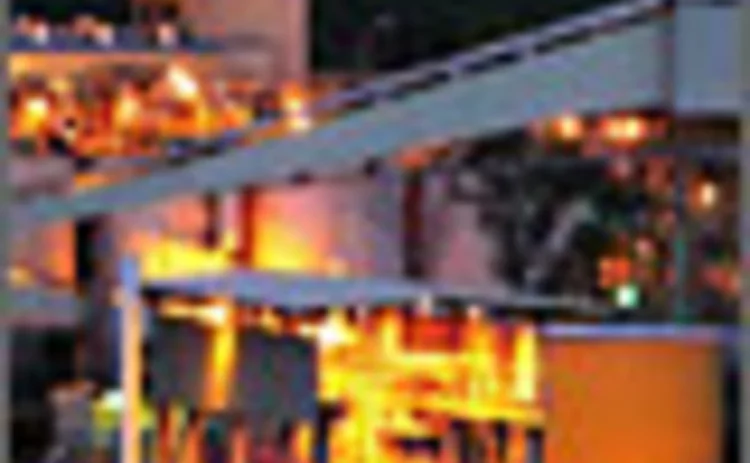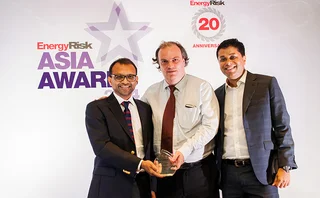
Rio's gamble
Consolidation in the aluminium industry, notably Rio Tinto's $38.1 billion move to acquire Alcan, has caused aluminium option prices to rise and the futures price curve - currently in backwardation - has flattened considerably. Kathleen Kearney reports

The strength of the balance sheet of Anglo-Australian miner Rio Tinto and the faith that investors place in its long-term diversification strategy has meant the company's demand for a $40 billion loan facility to acquire all of aluminium producer Alcan of Canada has caused hardly a ripple in global credit markets (see box). But aluminium option prices have soared and the futures price curve, currently in backwardation, has flattened significantly.
Rio Tinto is currently the world's eighth-largest producer of aluminium and Alcan the fourth largest, following its acquisition of Pechiney in December 2003. After the combination - likely in November - the new entity, to be called Rio Tinto Alcan, will be the world's largest aluminium producer, surpassing Russia's United Co Rusal in production terms.
While aluminium prices have lagged behind the trends in other base metals in the first half of 2007, the price of three-month aluminium traded on the London Metal Exchange (LME) has proven quite volatile during the past 12 months and has, of late, succumbed to deleveraging activity by funds invested in base metals. The white metal climbed from a low of $2,640 a tonne at the end of 2006, to touch a 2007 high of $2,914 a tonne on April 10, well in advance of the disclosure of the deal. The price then fell sharply, to around $2,600 a tonne in mid-August.
Given the high price that Rio Tinto is paying for Alcan - its bid was significantly higher than an earlier $27.7 billion offer from Alcoa of the US - the company has made a bullish assessment of the long-term demand for aluminium.
A number of analysts find the aluminium price implied by the deal overly optimistic. "We need to assume aluminium prices of $1.26/lb for the next four years and a long-term price of $1/lb to make this deal work," say Clarke Wilkins and Heath Jansen, metals analysts with Citi in Sydney and London, respectively, in a report published in July. "Our current assumptions are for cyclical prices of $1.10/lb and a long-term price of $0.80/lb."
At the close of trading on August 10, the cash price for aluminium was $1.148/lb, well off the mid-2007 high of $1.30/lb. But Rio Tinto may have improved its own cost structure by acquiring one of the lowest-cost aluminium producers in the industry at a time when costs in the industry worldwide have been rising, the analysts say.
Aluminium prices have clearly lagged the uptrend in other base metals this year, and this is partly due to aluminium being a processed metal like steel. "We are unlikely to see a cyclical spike in the aluminium price that we have seen in other base metals such as copper, nickel and zinc," the Citi analysts say.
"Aluminium behaves more like a processed commodity, such as steel, rather than a hard rock base metal such as copper, nickel or zinc. The industry dynamics of steel and aluminium are similar. In both instances, China is the swing producer and consumer, and China is naturally short the raw materials of bauxite (alumina) and iron ore (steel), and structurally deficient in energy," say the analysts.
According to commodity traders, the impact on the market was more noticeable in the far forward curve for aluminium. "If you go back even a few months, the aluminium forward curve was pretty backwardated," says Michael Skinner, a base metals salesman at Standard Bank in London. "In fact, the first part was in contango - that is up to about four or five months - and then you got backwardation, which dipped up and down all the way to December 10 and 11," adds Skinner, referring to the December 2010 and December 2011 contracts.
A typical market with normal growth and inflation expectations tends to form an upward-sloping price curve assuming equal rates of growth in supply and demand. When the price curve is upward sloping - in other words, when the prices of forward month contracts are higher than near-term contracts - prices are said to be in contango. And when prices of near-term months are higher than forward months, the trend is said to be in backwardation.
Backwardation is an abnormal market trend and can arise due to near-term supply disruptions, hedging by producers aiming to lock in near-term prices, which are sometimes both referred to as normal backwardation, or market manipulation. Producers have largely stopped hedging the price of future production for two reasons, which are linked: many suffered very large losses when the downtrend in prices shifted early this decade and, as a result, shareholder pressure has not allowed them to adopt new hedging schemes. Dealers add that there has been little sign of market manipulation.
But, following the announcement of the deal, "what you saw quite quickly was a play on the long-dated aluminium, a buying of December 2010 and December 2011 futures", says Skinner. "If you look at that, you can see the back end of the curve has significantly moved. Overall, the price curve has flattened considerably. It is completely different to what it was a few months ago," Skinner adds. The back end of the curve - that is, futures prices for 2011 and beyond - are trending below $2,450 a tonne, while cash is trading at around $2,525 and the 27-month contract at $2,600 (see figure 1).
"We have been advocates of purchasing the back end of the curve since about January, but we don't see much value to be had in the near-term aluminium market," says Skinner. Standard Bank analysts see consolidation in the industry and a more sustained effort by China to rein in some of its aluminium smelting capacity in the future as reasons why growth in aluminium supply will gradually decline vis-a-vis demand, resulting in long-term price appreciation. But any large changes in policy would probably be delayed until after the Olympic Games, to be held in Beijing in August 2008, when the international spotlight is no longer trained on China. This long-dated approach contrasts strongly with that adopted in other base metal markets like copper and nickel, where buyers are focused on the near-term outlook. "It is a long-term game for aluminium, a much longer game," says Skinner.
The backwardation in the price curve and the shunning of hedging strategies by most metals producers over the past few years has encouraged some producers to move to the options market when they want to lock in the current price level. But volatility in the underlying metals prices, including aluminium, has made this a costly strategy as well.
"There has been a pick-up in options trading. The main activity has been in December 2011 and December 2012," says Skinner, referring to LME-traded aluminium option contracts. "Options have become the way forward, but the main problem is that the volatility in the market has made them a lot more expensive than they have been before, especially when you have these massive sell offs," says Skinner.
Base metals prices fell sharply in mid-August as leveraged investors left the market, concerned that contagion from the US subprime mortgage market would drive down this market as well. So, while Rio's purchase of Alcan may be an astute far-sighted view on the future of aluminium demand and future prices, other dynamics - namely fears of a liquidity crunch - may be playing the larger role.
"People are deleveraging at the moment, and they are reducing risk and selling indiscriminately, anything they can do to raise cash, so why should aluminium be spared?", says John Reed, a metals analyst at UBS in London.
Investors could be selling long-dated contracts and buying back short-dated ones and other strategies, all of which could bring about a flattening of the price curve.
"Some common trades that people have been on are long the back dates; people have also had curve-flattening trades on, and against them are curve-steepening trades," says Reed. "These are getting liquidated at the moment and it is responsible for the shape of the curve. People are beginning to factor-in lower potential growth and also the rising aluminium stocks, which is why the front end is coming down as well," he adds.
Viewed from the macroeconomic hilltop, it appears that the aluminium market has changed: production costs are rising and the cost of hedging current and future output has also risen, while demand growth is uncertain.
"On the surface, the current economic environment appears unfavourable for commodities. The Chinese authorities are trying to slow their economy, US domestic demand has expanded at a sub-3% pace for the past five quarters, and subprime fears are reducing the availability of corporate credit," says a report from the Bank Credit Analyst research newsletter in Montreal. The analysts see the boom in global capital spending and income gains in emerging economies offsetting the weakness emanating from the US housing market. "Volatility in commodity prices will rise, but the uptrend in long-dated commodity futures looks sustainable," say the analysts.
FUNDING ON TRACK
The bid by Anglo-Australian mining company Rio Tinto for Canada's Alcan represented a 66% premium to Alcan's share price prior to another $27.7 billion offer made in May by Alcoa, which subsequently withdrew its bid.
And, despite the global credit shakeout caused by problems in the US subprime mortgate market, the estimated $40 billion funding needed for Rio Tinto's takeover still looks to be on track. "There has been a bit of a ripple effect; but spreads across the investment grade markets are just three to seven basis points (bp) wider and it depends on which names you look at," says Chris Marrow, managing director for debt origination at Credit Suisse in London, referring to prices of five-year, credit default swaps (CDSs). "Most of the impact has been felt in the collateralised debt obligations, collateralised loan obligations and leveraged loans, and the investment grade market remains very robust."
The mining company's loan is likely to comprise a $15 billion one-year term loan with a one-year extension option, a $10 billion three-year revolving credit facility, a $5 billion five-year revolving credit facility and a $10 billion five-year term loan, according to Deutsche Bank, one of the arrangers of the financing for Rio Tinto. The Royal Bank of Scotland, Credit Suisse Group and Societe Generale are also financing the offer.
Rio Tinto currently has a single-A rating due to its strong cash flow and low gearing, which, as of the end of 2006, was about 6%. Following the fundraising, the company's gearing is forecast to rise to about 60%. The deal is an all cash deal. However, Rio Tinto has said that it will raise as much as $10 billion through asset sales, of both its own and Alcan's non-core assets. As such, the company should be able to maintain a solid single-A rating, bankers connected with the fundraising exercise say.
As of August 15, the syndication of the loan was going well, according to one banker connected with the deal. But he would not disclose how it was being structured or any pricing details.
"There was certainly some pretty intense speculation before the deal was actually announced; it was pretty well telegraphed that (Rio Tinto) was looking at (Alcan) so, in the lead up, Rio was trading around 15bp in the five-year, single-name CDS," says David Hawkins, executive director of credit trading at JP Morgan in Sydney. "The widest premium that we traded was 28bp. We then sort of fell back to 22bp and settled at around 25bp," Hawkins says.
Uncertainty over the post-merger outlook for the company could easily push spreads much wider. Ten basis points is still a very tight spread, Hawkins adds. "It is basically a reflection that it is going to have to go and raise a fair lump of debt to pay for (Alcan), and there will be a supply/demand imbalance and certainly that would not have worked to the 15 level, so you have had a bit of a repricing," says Hawkins.
Traders have contrasted the deals with the takeover offers for Australia's flagship carrier Qantas Airlines by a Macquarie Bank-led consortium, Airline Partners Australia, which made a A$11.1 billion offer, earlier this year. The Qantas management and the board, which supported the bid by Macquarie, believed that Qantas would need to increase its capital expenditure on new aircraft and improve efficiencies to compete with low-cost carriers.
However, shareholders and the market were concerned that these private equity firms, which generally are seen as having short-term investment horizons, would take the airline through a savage restructuring, gear-up the company and then strip it of its most valuable assets. The credit rating on the airline was also seen falling to a single-B rating.
"With Qantas, we saw spreads go from 30bp out to 253bp," says Hawkins. In November 2006, prior to the private equity offers, the spread was trading at 30bp. "To put that into perspective, after September 11, 2001, we saw considerable volatility in global airline CDS pricing. Qantas got as wide as 180bp, so it went considerably wider than in the dark days of September 11," he adds. The deal was pulled in May, with dealers that offered contingent currency and interest rate hedges losing significant sums of money.
Only users who have a paid subscription or are part of a corporate subscription are able to print or copy content.
To access these options, along with all other subscription benefits, please contact info@risk.net or view our subscription options here: http://subscriptions.risk.net/subscribe
You are currently unable to print this content. Please contact info@risk.net to find out more.
You are currently unable to copy this content. Please contact info@risk.net to find out more.
Copyright Infopro Digital Limited. All rights reserved.
As outlined in our terms and conditions, https://www.infopro-digital.com/terms-and-conditions/subscriptions/ (point 2.4), printing is limited to a single copy.
If you would like to purchase additional rights please email info@risk.net
Copyright Infopro Digital Limited. All rights reserved.
You may share this content using our article tools. As outlined in our terms and conditions, https://www.infopro-digital.com/terms-and-conditions/subscriptions/ (clause 2.4), an Authorised User may only make one copy of the materials for their own personal use. You must also comply with the restrictions in clause 2.5.
If you would like to purchase additional rights please email info@risk.net
More on Metals
Interview: Can Matthew Chamberlain rescue the LME?
London Metal Exchange CEO identifies problems, awaits contract and fee structure revamp feedback
Base metals dealer of the year: BNP Paribas
French bank expands hedging and finance solutions to mainland China
Asia precious metals house of the year: Citi
Citi builds full-service Asia strategy as others exit market
LME Clear ‘welcomes scrutiny’ of CCP risk management
Oversight from clearing members is good for central counterparties, says LME Clear CEO
Metals house of the year: SG CIB
Barclays and Jefferies Bache deals highlight bank’s commitment to metals
Metals traders shun clearing due to Emir, says LME chief
Emir segregated accounts pushing firms to trade OTC, says Jones
LME eyes Asian growth while dealing with regulation
Garry Jones on China, warehouses, clearing and financial regulation
Energy Risk Asia Precious Metals House of the Year: ANZ
ANZ connecting physical players with reach and structuring ability







